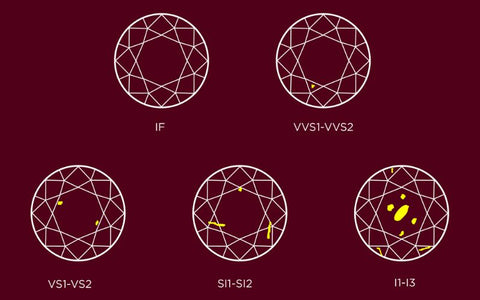HOW TO CHOOSE A DIAMOND
When it comes to diamond shopping, there’s a lot to consider. What kind of stone exemplifies your love story? Should I buy a diamond online? How do I know it’s a real diamond? The process can go from joyful to daunting if you’re not sure what to look for. We’ve broken down the essentials with what the Gemological Institute of America (GIA) deems the four C’s, the most important characteristics when it comes to diamond shopping.
View the MICHAEL M Crown collection.
CARAT WEIGHT- A major factor when it comes to price, carat weight is the weight of the stone. This reflects the overall size as well. One carat equals .2 grams. A larger diamond is generally more valuable than a smaller one, but the value is also influenced by the other three C's.

CLARITY- There are five grades of clarity, and also five levels of grades. GIA notes that a grade of VVS1 (very very slightly included) or VVS2 is ideal, as the inclusions in these grades are barely visible to the naked eye.. Diamonds with an IF (internally flawless) grade which means under 10x magnification, there are no visible flaws. Asscher and Emerald cuts tend to show more imperfections than a Round cut.

View the MICHAEL M Princess collection.
COLOR- When diamonds are mined, they don’t always come out sparkling. The market grading scale ranges from D-F for colorless, G-J for near colorless, K-M faint, N-R very light, to Z for being yellow in color. The color of a white diamond is graded D to F, while colored diamonds are deemed at best vivid and at worst light fancy.

COLORLESS
- D-F: The highest grade of diamond, completely colorless with the most brilliance.
ALMOST COLORLESS
- G-H, I-J: Near colorless diamonds, but great value.
FAINT COLOR
- K: Faintly noticeable color within the stone, but more affordable.
- Z: At the bottom of the scale when it comes to quality, these diamonds have a noticeable yellow hue. These are not the same as Fancy diamonds, graded on a different scale.
CUT- Cut refers to how well the diamond has been cut and shaped, affecting its ability to reflect light. A well-cut diamond will have more sparkle and fire, while a poorly-cut diamond may look dull or lackluster. An excellent cut has very few if any imperfections, high brilliance, symmetry, and light reflection, while a poorly cut diamond will be glassy and dull without any symmetry or brilliance.
Ideal: Very few if any imperfections and high brilliance. High light reflection.
Very Good: Slight imperfections that aren’t visible to the naked eye. Reflects as much light as the ideal but for a lower price.
Good: Few imperfections. The brilliance of the diamond might be impacted by aspects such as a pavilion angle variation or a missing facet.
Fair: More dull with several imperfections. The brilliance of the diamond is lowered by misshapen features.
Poor: Glassy, dull and without any symmetry. No brilliance.

CERTIFICATE
Authenticity is paramount when it comes to a diamond. Be sure you receive a certificate from an accredited, internationally-recognized body like the GIA. It means that the diamond has been independently assessed for authenticity and graded according to its quality.
Any diamond purchase should come with this certificate; not one that is written in-house by the jeweler or dealer as this bears no meaning on the stone’s authenticity. Each stone should also have a laser inscription corresponding to its certificate, which should be checked by an independent third party.


Leave a comment